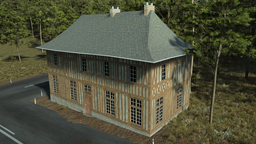Export from Revit
It is possible to import Revit project as OBJ files in NDunes. However there are different process to follow depending on the version of Revit being use for the project. It is also possible to export FBX and OBJ files from Revit, this documentation will describe how to export both of these format.
To keep the documentation light and understandable, this page will only refer to the native functionalities in Revit. There are plugins available online that can allow other possibilities but they will not be covered here.
Below is a description of the different process to export FBX and OBJ files for Revit.
Note:
Remember to separate the "ground" of your project from the actual point of interest as they should be imported separetly in NDunes, the ground as a "geometry ground decal" and the model as a normal geometry. For more information go to Import model as geometry ground decal
Export FBX files
Revit can natively export FBX files. However they will not contain the materials of the project which can cause a number of problems when importing a model in NDunes.
To export to FBX the steps are the same on all Revit version :
- Launch Revit and open your project
- Click "View>3D View"
- Click "File>Export>FBX"
- Chose a location and click "Save"
To import FBX file you can follow the steps described in Defining a geometry
Export OBJ files
Note:
OBJ file export is only for Revit 2022.1 and later releases. If you are using Revit 2022 you will need to install the 2022.1 update first.
For Revit 2022.1 and above :
- Launch Revit and open the project
- Click "View>3D View"
- Click "File>Export>CAD Format>OBJ"
- Chose a location and click "Save"
After the export, if the model has materials, an .MTL file will be created in addition to the OBJ file. You need to always keep the .MTL file in the same folder as the OBJ and with the same name when importing it in NDunes to retrieve the materials.
The process to import a model in NDunes can be found on Defining a geometry
 Convert 3D files from CAD softwares Convert 3D files from CAD softwares | Export 3D files from Archicad |





